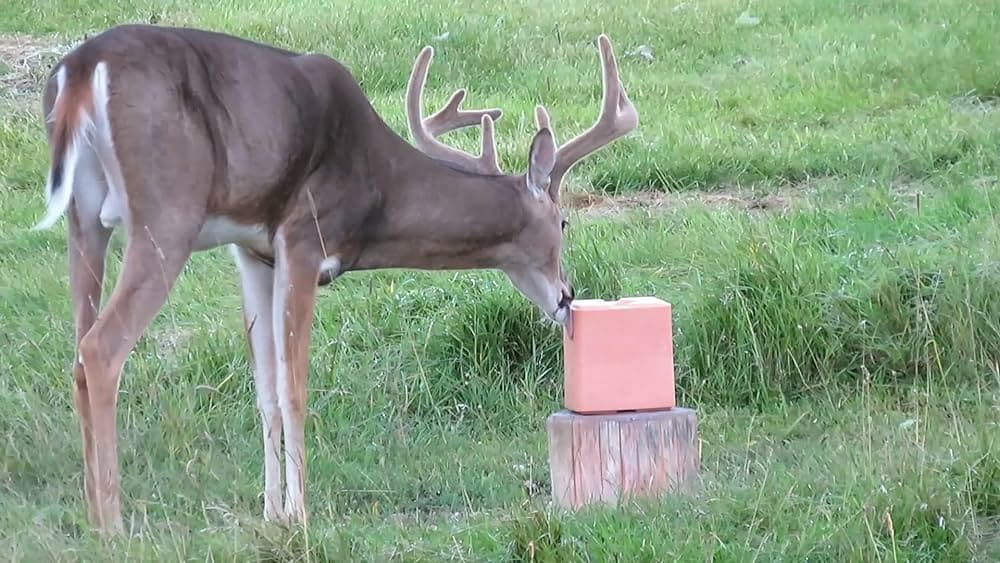Deer hunting is an exhilarating experience that demands meticulous planning and preparation. Knowing when to put out salt blocks for deer is a crucial part of this strategy.
Deer, like any other animal, require necessary nutrients to keep healthy and prosper. A deer’s diet must include both salt and minerals. Salt and mineral blocks are essential supplements that can help deer grow healthy and strong, and they can also attract deer to your hunting area.
Knowing when to lay out salt blocks for deer is critical for both wildlife enthusiasts and hunters. Understanding the timing of their deployment can have a considerable impact on the health and well-being of deer populations.
When deciding the optimal time to supply salt blocks, it is vital to consider individual area elements such as climate and habitat. Keep reading to learn when to set out salt blocks for deer and how to ensure you’re doing it correctly.
Table of Contents
Why Is Timing Crucial When Spreading Salt Blocks Out For Deer?
Salt is an essential nutrient that helps regulate the body temperature of deer and maintains fluid balance. Knowing when to place salt blocks out for deer is important for 4 reasons.
Timing For Effectiveness
When to spread salt blocks out for deer refers to the timing of placing salt blocks in areas where deer are known to frequent. Placing salt blocks at the right time, aligns with deer’s natural nutrient needs during these seasons, making them more likely to utilize the salt blocks.
Nutritional Supplementation
Salt blocks are a good source of trace minerals like zinc and copper as well as important minerals like calcium, phosphorus, and sodium. These minerals are essential for the growth of deer’s bones and their general wellbeing. Lacking these nutrients can lead to health issues, including reduced antler growth and reproductive problems.
Supporting Deer Populations
Adequate mineral consumption contributes to healthier deer populations. Healthy deer populations can benefit ecosystems by affecting plant diversity through feeding patterns and supplying food for predators.
Enhancing Wildlife Observation
For wildlife enthusiasts, salt blocks can draw deer to certain spots. This makes it easy to view and appreciate these animals in their natural environment.
When To Put Out Salt Blocks For Deer?
Late winter and early spring are often the best times to distribute salt blocks for deer. Deer are actively seeking additional nutrients throughout these seasons to sustain their growth and reproduction. The colder months might deplete their supplies, leading them to seek for additional mineral sources. This timing aligns with their biological needs, ensuring they benefit most from the added minerals.

Before the hunting season is also the time chosen by many hunters. Putting out salt blocks prior to hunting season will help attract deer to your hunting location and encourage them to stay longer. This can improve your chances of seeing and shooting a deer during hunting season.
Salt blocks are a great method to enrich a deer’s diet and provide them with the nutrients they require. Natural sources of water and food can become short during droughts, and deer may suffer from dehydration and starvation. Laying out salt blocks during these times can help supplement their food and keep them hydrated.
Furthermore, after harvesting, farmers typically have leftover crops, and deer can benefit from the nutrients in these crops. Leaving salt blocks in fields where crops have been harvested can attract deer while also providing them with the nutrition they need.
It is crucial to remember, however, that the actual timing may vary based on your location. When to spread salt blocks efficiently is influenced by climate, habitat, and local deer numbers. Local wildlife rules must also be considered, as certain places may impose restrictions or guidelines on the use of salt blocks.
Comparing Salt Blocks And Mineral Blocks
A deer’s diet must have salt and minerals as these are two essential nutrients for its existence. Although salt blocks and mineral blocks share some similarities, there are still differences between the two supplements.
- Nutrient Content: Salt blocks primarily contain sodium, while mineral blocks contain essential vitamins and minerals such as calcium and phosphorus.
- Purpose: The primary purpose of salt blocks is to supplement a deer’s diet with essential minerals. Mineral blocks serve a similar purpose, but they also provide deer with essential vitamins that can help promote overall health and wellness.
- Timing: The timing of when to put out mineral blocks for deer will be different from the salt block depending on its needs. Salt blocks are typically used to attract deer to hunting areas. Mineral blocks, on the other hand, are used to enhance a deer’s diet during important times, such as pregnancy and antler growth.

Advice On Placing Salt Blocks For Deer
In order to maximize the effectiveness of salt blocks for deer, meticulous planning is necessary. Here are seven essential tips:
- Choose High-Quality Supplements: Not all salt blocks are created equal. Pure salt blocks without any additives are ideal for deer. Look for products with a balanced mineral profile.
- Place Blocks in Strategic Locations: Ideal spots include areas frequented by deer, such as travel routes, near water sources, or in proximity to their bedding or feeding areas. Placing salt blocks in shady areas away from direct sunlight can prevent them from melting too quickly. It is important to keep salt blocks clean and free of debris to avoid contamination.
- Camouflage and Concealment: To prevent scaring the deer, try to disguise the salt block as much as possible. Use natural cover, such as fallen branches or leaves, to blend it into the environment.
- Spacing and Quantity: Avoid overcrowding with salt blocks. Place them far enough apart to prevent territorial disputes among deer. One or two blocks per 100 acres is usually sufficient.
- Monitor with Trail Cameras: Setting up trail cameras near the salt block can help you track deer activity. Keep an eye on how much the deer are using the supplements. If they’re not being used, consider moving them to a different position or switching to a different sort of supplement.
- Safety Precautions: If you’re using loose salt or minerals, keep them in a secure container to avoid unintentional consumption by non-target animals. Using a sturdy container that can withstand harsh weather conditions is recommended to protect the salt and mineral blocks from elements.
- Maintenance: Check the salt blocks on a regular basis and replenish as needed. Keep them at least five feet away from permanent water sources. They can dissolve or erode over time, so ensure deer always have access to the minerals. Additionally. replace the blocks regularly, and monitor them to ensure they remain clean and free of debris.
Conclusion
Knowing when to lay out salt blocks for deer is critical for any hunter or landowner. By following the rules mentioned in this article, you can guarantee that your deer are obtaining the nutrition they require to grow. Remember, when it comes to attracting deer to your hunting area, a little supplement can go a long way.

